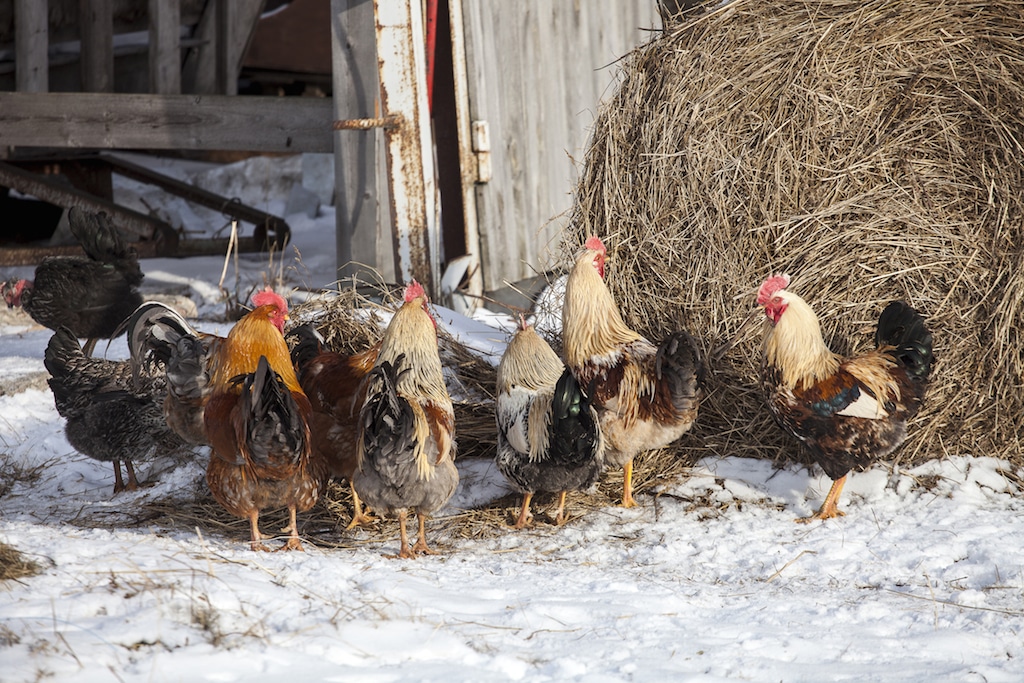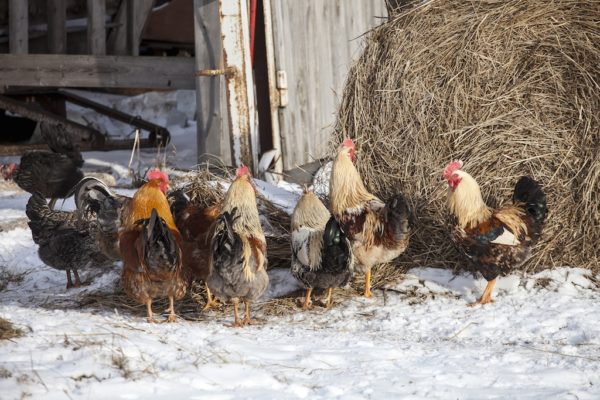
We’ve worked hard to understand the needs of our customers all over the United States, and with the cooler weather season approaching, we’ve asked our resident chicken expert to weigh in on best practices for cold weather backyard chicken-keeping.

Chickens, with the notable exception of Silkies and Frizzles, are by nature much more cold hardy than they are heat tolerant.
The design concept of Roost & Root coops provides for three basic spaces for your chickens. (1) Roost Area (2) Egg Box Area, and (3) Run Space. Each space has its design goals, taking into consideration cold and hot climates.
#1 Roost Areas
The Roost area will be used by your chickens primarily at night to sleep. Exceptions to this will be when your birds feel they need additional shelter because of inclement conditions. They will seek shelter in the roost. Roost & Root coops feature enclosed roosts made from thermally neutral cedar (neither transmits cold or hot) and use updraft passive ventilation so that hens in the roost are protected from stagnant air issues. In hot or cold weather, air circulates from low to high and out the tops of the roosts even though they are enclosed and protected, making sure your chickens stay healthy year-round.
By nature, chickens have a good way to deal with inclement weather. Chickens are very temperature hardy, much better at dealing with extreme cold weather than extreme heat. Poultry experts agree that a dry, wind protected adult chicken allowed to feather up prior to the winter season, can do just fine in freezing temperatures… even sub zero temperatures.
Oddly, overheating of your chickens and frostbite issues have a common root cause…poor ventilation. Frostbite is driven by sub freezing temperatures and overly humid coops that are too enclosed. In the worst coop designs, humid sub freezing temperatures exacerbated by the chickens poop moisture (common with poop trays) and respiration can cause frostbite on exposed combs and leg skin even on a dry chicken. Heaters and light bulbs must be used with great care as they introduce the risk of electrical fires and can actually cause fowl to not “feather-up” the way they otherwise would, and in a power outage, it potentially leaves them without their full natural feathering to keep them warm.
#2 Egg Box Areas
For a different reason, egg box areas are enclosed too. Darkness. Chickens will naturally want to lay their eggs in the darkest most cozy areas of the coops. Our egg boxes, for the same reasons as our roost, afford your chickens refuge from poor weather conditions while they are laying yet keep critical fresh air circulating around them.
#3 Runs
Runs are just that, a run area for your chickens, and a place for them to get outside and forage around. Our run areas have roof areas over them to provide some shade and some protection from normal rain and snow accumulation. At the same time, our runs allow sunlight to shine in too. Sunlight drys up your coop areas, the ultraviolet light disinfects your coop and helps control odors, and in fact as with most animals, chickens need sunlight. So they are necessarily more open than roosts and egg box areas. In extreme stormy conditions (wind driven snow and rain), your chickens even though it is daytime, will seek shelter in their roosts. They’re now out of the storm, but confined to a smaller space. So that the run areas can have both the openness that’s appropriate the vast majority of the time, but to extend use of the run in seriously stormy weather, we’ve introduced optional Storm Panels™ that will add temporary additional inclement weather protection to run areas. You don’t have to have them, but it’s a smart choice as they offer more sheltered space to your flock when it’s stormy outside.
Remember:
- For many of us, chickens have become pets. Leaving Fido out in inclement weather is just not usually an option. With that said, pets or not, chickens are still livestock. An adult chicken given good choices for different shelter areas (roost, egg box, run) can figure out what areas they need to be in to deal with the weather. Depending on your world view, they’ve been doing it for somewhere between 10,000 and 10 bizillion years. We’ve only had electricity for a little more than 100 years and chickens have certainly done well for much longer than that all over the world.
- The fact is that cold isn’t as big a problem for chickens as heat. They can withstand very cold temperatures (even subzero) as long as they are fully feathered adults. Generally a chicken is fully feathered out by the age of 12 weeks, but does sometimes depend on the breed. If your chicken has full wing feathers and feathers over it’s neck and middle, it’s safe to consider them fully feathered. If you have a Round-Top Backyard Chicken Coop™ make sure to place your roost door away from the prevailing or coldest North winds just to give them a bit of extra protection, or you could get a Snow / Storm Panel kit which includes a cover for that door. Lower your roost wings on your Mobile Coop and the roost area becomes a great place to get out of the weather. Likewise, the Walk-In Coop has a giant enclosed roost area where your chickens can seek refuge if they think they need it.
- The problem with cold and chickens actually comes from moist cold air. Moist cold air causes respiratory problems and can cause frost-bitten combs and wattles in very cold temperatures. The roost-over run design of the Round-Top Backyard Chicken Coops™ takes this into account and provides ventilation through the roost floor and allows the cold moist air to dissipate out the top round vents. The roost bars are positioned to allow the chickens to roost near the top where the air is warmest, but out of direct wind.
- Keep water from freezing by using some sort of a submersible heater or heated chicken waterer. If you have the Easy Fill Waterer, we have designed it for a particular heater and all that is needed is the slotted cap.
- Extra shavings in a sloppy coop run bottom can absorb water and help keep your girls feet dry. Do not use straw or hay as it holds moisture and turns into a mildewy matted mess.
- On really cold sub-zero days, you can use a bit of Vaseline to coat combs , waddles and exposed leg skin to protect from frostbite.
- Cold birds will huddle up together to keep warm and in the heat, the opposite is true.
- Be careful if you decide to use a light-bulb or a heater. The electricity presents an electrocution and fire hazard and you may in fact be doing harm. IF you provide too much supplemental heat, a bird’s natural reaction is to not feather up as much. IF you were to lose electricity in a cold spell, your birds would be without some part of their best natural defense against cold…their feathers.
- Keep unfrozen fresh water available to your hens. Hydrated birds deal with cold better.
Dry, fully feathered chickens that can get out of the wind are very, very cold hardy. They will be fine in freezing temperatures (even sub zero temperatures) so long as they have access to fresh water and stay dry. Some particulars may vary breed-to-breed, for instance Silkies and frizzle-feathered chickens are less cold hardy. The above points will certainly give you a safe place to work from.
Contact us if you have winter chicken keeping questions. While we live in Central Texas and only have 30 or so freezing days each year, we have thousands of customers in places like Maine, Connecticut, Massachusetts, Minnesota, Colorado and many other very cold places. We literally get NO reports of cold weather related chicken deaths with our coops. We’re happy to share with you what we know.


